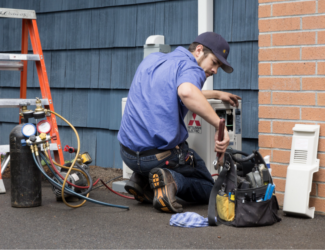
Portable generators
Portable generator safety
So you’re interested in getting a portable generator…
Maybe you want to make sure food in your freezer stays frozen if there’s a power outage. Or you need to power the well pump that provides you with drinking water. Or you want to be able to use your gas or oil furnace when the power’s out. Or your at-home business requires power to run computers or other equipment.
Whatever the reason, whenever there is an extended power outage, there is also the urge by many customers to fire up the portable generator to get electricity flowing to certain appliances. But, if not used properly, that portable generator can pose a severe hazard to line workers and your neighbors. In addition, the generator itself can be damaged if not connected properly.
Do not plug the generator into your home’s electrical system, unless you use a transfer switch. The generator can back-feed electricity to the PUD system through the main breaker and create a dangerous situation for PUD line crews working to restore power. We recommend:
- Using a transfer switch with a generator, but if your home doesn’t have one, flip the home main breaker to the “off” position.
- Run extension cords from your generator to power up lights, appliances, etc., instead of plugging your generator into your home’s electric system.
Also, according to the Consumer Product Safety Commission, using a portable generator INDOORS (even with windows and doors open) can kill you in minutes because exhaust from the portable generator contains high concentrations of carbon monoxide (a poison that cannot be seen and has no odor). DO NOT place a portable generator inside your home or garage when you are running it.
Recent incident:
While working on a pole replacement, a PUD lineman felt a “buzzing” on the service line even though it had not been hooked up to a transformer. The crew quickly stopped work. When they did, they heard a generator running. They followed the sound and talked to the customer about the situation his generator was causing. Generators not properly installed can “back-feed” onto the PUD’s system, which can cause a dangerous situation when crews are working. Fortunately, the issue was discovered before anyone was injured. The customer was advised to have an electrician inspect his panel and correct the problem. It’s critical that customers not plug their generator into their home’s electrical system unless it has an installed transfer switch. If you have questions about generators, call 425-783-1000.
Please click here for a brochure about what you need to know BEFORE buying a portable generator.
Frequently asked questions about portable generators and using them safely:
How do I select a portable generator?
The first step in purchasing a portable generator is to identify the things you absolutely cannot live without during a power outage. Usually high on the list will be the refrigerator and the freezer, a well pump, the furnace fan if you have natural gas or oil heat, or maybe some lighting. Consider your list carefully, because the bigger the portable generator, the more expensive it will be.
Once you have your list, calculate how much electricity those items need. Look at the wattage of each item on the equipment nameplate or in the owner’s manual, and add it all up. Then keep in mind that your generator should not be run continuously at more than 80 percent of its rated capacity and take into account that appliances that operate with a motor (like the refrigerator and freezer) can require two to ten times their listed wattage in order to start.
Once you factor in those conditions, you can determine the size of the portable generator you’ll need.
What can happen if I don’t use the generator properly?
The most common problem is something called back feed. This occurs when a generator is connected to the home’s wiring system.
The problem typically occurs during a power outage when a homeowner with a forced-air natural gas or oil-fired furnace tries to operate the furnace fan by plugging the generator into an electrical outlet and feeding power into the home’s electric system. That’s when back feed happens.
The electricity from the generator will flow through the home’s wiring, out of the house through the electric meter, the voltage will get increased to about 7,200 volts as the current passes through the transformer outside (yes, it works in reverse), and then it will flow into the PUD’s electric system — posing a potentially fatal shock hazard to anyone working on the power line or coming in contact with a line that might be sagging or on the ground.
Can this also damage my generator?
Yes, it can. When our utility workers work on a power line, they routinely use a grounding system to protect themselves. If a portable generator is back feeding to that ground, the generator could be severely damaged.
Also, when we restore power to a home that has a portable generator connected to the wiring, the sudden flow of utility power into the portable generator could burn out the machine.
Can’t I accomplish the same thing by throwing the main breaker?
Not safely. Simple circuit breakers do not make a positive disconnection between the home electric system and the PUD system. What’s more, they’ve been known to fail. And, the consequences are pretty high if it does fail.
The only safe way to create a positive disconnection between the two electric systems is through the use of a transfer switch.
Are there other safety tips I should keep in mind?
Yes. Make sure extension cords are adequately sized to handle the electricity. If you’re not certain, ask the dealer who sold you your generator or check with an electrician. Also, the generator itself should always be placed outside in a well-ventilated area and you should never refuel it when the engine is hot. Let it cool for at least 10 minutes to minimize the danger of fire.
According to the Consumer Product Safety Commission, using a generator indoors can kill you in minutes, even if the windows and doors are open. The exhaust contains high concentrations of carbon monoxide, a poison that cannot be seen and has no odor. If you are running a portable generator, do not place it in your home or garage.
Instructions on how to properly use a portable generator are included in most operating manuals. You should read them carefully.
What is the wattage of a few common items, just as a guide?
- Furnace Fan – 500 to 2,350 starting watts, depending on its size
- Refrigerator or Freezer – About 2,200 starting watts
- Well Pump – 1,400 to 2,100 starting watts
- Sump Pump – 1,300 to 2,150 starting watts
- Garage Door Opener – 1,100 to 1,400 starting watts
- Electric Fry Pan – 1,300 watts
- Coffee Maker – 1,750 watts
- Microwave Oven – 625 to 1,000 watts






